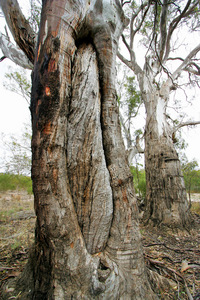
Aboriginal canoe trees around found along the Murray River

The explorer Edward J. Eyre, Protector of the Aborigines 1841-44 at Moorundie, near Blanchetown, described one canoe as formed from a single piece of bark 4.5m long 0.9m wide and about 20cm deep. The bow was pointed, slightly more than the stern and the craft had a flat bottom. Construction was seemingly simple, but required patience and much skill. Bark was removed from river red gums only during summer, when the sap ran freely. First the required size and shape of the canoe was cut, with a digging stick, through the bark to the hardwood core. The bark was then slowly prised from the tree by the use of numerous smaller sticks.
The whole slab was held in position by forked branches or hand-woven rope. When finally separated from the tree the slab was lowered to the ground. Flat on the ground, small fires were lit on the moist inside of the bark, which evaporated the sap and made the bark curl upwards. The ends were then pulled together and stitched with hemp and plugged with mud. Stretchers were inserted to hold the open shape. After tying it was allowed to mature when it was constantly rubbed with grease and ochre. Such a craft had a life of about two years.
There are examples of such canoes in the Adelaide and Melbourne museums.

Learn more about Indigenous Australians
- Welcome to Country
- Visit Mungo National Park
- Ngarrindjeri Dreamtime Story of Ponde and Ngurunderi
- Nildottie - Evidence of Indigenous Australians over 5,000 years ago
- Aboriginal Canoe Trees
- Murray River Aborigines (North-Western Victoria)
- Bunyips have their origins in the folklore of the Aborigines
- Take a tour with Paakantji traditional owner at Mungo
- National Landscapes
Tell your friends you found this at murrayriver.com.au!
Copyright Discover Murray 2025. This site or any portion of this site must not be reproduced, duplicated, copied, sold, resold, or otherwise exploited for any commercial purpose that is not expressly permitted by DISCOVER MURRAY.






 Little By Little
Little By Little Amy Shark The Solo Acoustic "Songs & Stories" Tour
Amy Shark The Solo Acoustic "Songs & Stories" Tour Lee Kernaghan Boys From The Bush The Concert
Lee Kernaghan Boys From The Bush The Concert The Australian Beach Boys Show
The Australian Beach Boys Show Kevin Bloody Wilson Aussie Icon Tour with special guest Jenny Talia
Kevin Bloody Wilson Aussie Icon Tour with special guest Jenny Talia